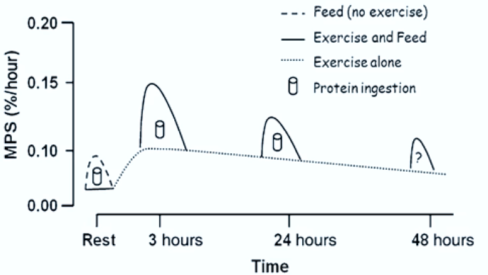As a serious bodybuilder you have probably heard of the (Post-Workout) Anabolic Window of Opportunity. The old rule about that window says that you should eat protein within 30 to 60 minutes after training, if you want to at least secure your gains.
Hopefully you know by now that this ‘rule’ is nonsense, which certainly does not mean that the anabolic window does not exist. YouTube oracle Jeff Nippard explains exactly how that works in one of his latest videos.
MYTHS AND BRO SCIENCE
Nippard explains how the myth surrounding the anabolic window could have arisen. The culprits are probably some old studies that were poorly designed. The subjects in those studies who grabbed a protein shake after training did record more muscle gains than those who didn’t, but that was because they were simply taking more protein in total.
Bro science then did the rest: a persistent myth was born and lives on to this day.
HOW IT REALLY IS
Fortunately, countless new studies have been done over the past two decades that have seriously undermined that bro science. The anabolic window does exist, there is no longer a discussion about it, but it does not close within 30 or 60 minutes after training. In fact, that window can stay ‘open’ for 24 to 72 hours.
In other words: the muscle protein synthesis necessary for muscle growth is increased for tens of hours after a (good) training. Exactly how many hours depends on things like training status, intensity, amount of sleep, age, and so on. The fact is that your muscles are extra sensitive to protein intake during those hours compared to someone who has not trained.
IN PRACTICE
If you train several times a week, you simply have to make sure that you eat enough proteins every day, namely about 2 grams per kilogram of body weight. This regardless of when you train.
In addition, it has been scientifically proven that it is best to divide your proteins more or less evenly over four to six intakes, ie meals with 20 to 40 grams of high-quality proteins, always with three to four hours between meals.
The figure below, which Nippard shows in his video, makes all this pretty clear: muscle protein synthesis (MPS) often remains elevated for at least 48 hours and must be ‘fed’ with protein from food during that period. Both animal and vegetable protein sources are sufficient for this .
 After training, muscle protein synthesis (MPS) often remains elevated for at least 48 hours. The peak in MPS seems to be around two and a half to three hours post-workout. (Source: McMaster University, 2014/Jeff Nippard)
After training, muscle protein synthesis (MPS) often remains elevated for at least 48 hours. The peak in MPS seems to be around two and a half to three hours post-workout. (Source: McMaster University, 2014/Jeff Nippard)The figure also suggests that the MPS is highest in the hours (not minutes!) after training. That is why it is wise to plan your training between two protein-rich meals. If you train more or less on an empty stomach, a protein shake immediately after training is a good idea. After all, your body will not have access to the proteins from a pre-workout meal.
By the way, you certainly don’t need to worry about the timing of carbohydrates around the training either, as we explained earlier.
Below is Nippard’s complete, crystal-clear explanation, in the context of his ‘MYTH BUSTED’ series.